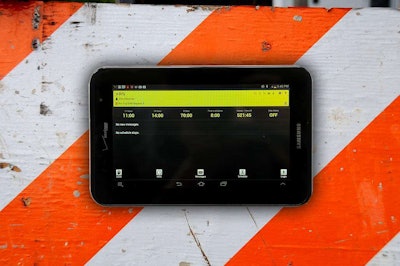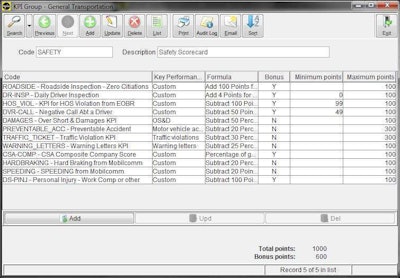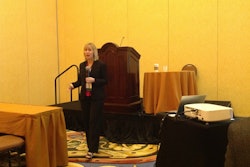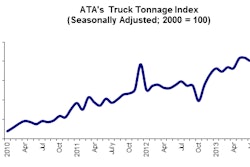Editor’s Note: This is the final installment in a two-part series on technology and performance-based driver pay. The first part covered the science behind scoring drivers. This article reviews off-the-shelf technologies that can score driver performance and automate payroll.
 The new XRS mobile platform has an online portal drives can use to view scorecards when vehicles are not in motion.
The new XRS mobile platform has an online portal drives can use to view scorecards when vehicles are not in motion.Three years ago, the private fleet for Nalco Champion stationed at the company’s plant in Garyville, La., began using Turnpike, a mobile fleet management system from XRS Corp. Nalco produces chemicals for the gas and oil supply chain from the well to the refinery.
Right out of the gate, Nalco began using the system to automate payroll for more than 900 drivers. Drivers are paid by the hour; change-of-duty status records in the system’s electronic log application capture their shift start and stop times.
A driver scorecard feature in Turnpike also keeps track of hard braking and over-speed events for Nalco. These two metrics go into determining the amount drivers will receive for an annual bonus, says Joe Neucere, the company’s onboard computer administrator.
Nalco is one of many fleets that use turnkey applications to score drivers and automate pay and incentive programs. A number of technologies that fit this description are becoming more critical as carriers look to restructure their driver pay based on a wide range of performance categories.
Driver feedback
Telematics systems have been reporting vehicle and driver performance data for years, but the reports have always gone to fleet management. Recently, new features are being added to give drivers immediate feedback in the cab to compare their results to fleet goals and to their peers.
PeopleNet is developing an in-cab driver scorecard for its mobility platform. When the vehicle is in motion the scorecard will use text-to-voice functionality to alert drivers to areas where they are not performing well, such as fuel economy. Drivers will be able to see their overall score while driving. When stopped, scores can be viewed in more detail, explains Rick Ochsendorf, PeopleNet’s senior vice president.
Rand McNally currently offers a stats menu in its TND 760 and TPC 7600 systems. Drivers can click on the stats icon to see how they are performing for the day and over the past month for mpg, idle time, hard braking, shifting, speeding and other areas.
The new XRS mobile platform has an online portal that drivers can use to view scorecard data. The platform is compatible with a wide range of smartphones and tablets. When in motion, the screen shows drivers the hours they have available. When stopped, drivers can login to the XRS portal to see the same live performance data that management sees for fuel economy, compliance, safety and other areas.
Omnitracs says its Performance Monitoring application can be used to deliver instant alerts and summary driver data to fleets. With the multi-media capabilities of its Mobile Computing Platform, users can automatically send scorecard reports they have created in the office to drivers as PDF files, for example.
Virtual driver coaching
Rather than wait for reports and scorecards to give drivers feedback, several new technologies have been designed to provide a real-time, adaptive coaching mechanism.
 PedalCoach is a digital gauge that trains drivers how to optimize throttle input and gear selection.
PedalCoach is a digital gauge that trains drivers how to optimize throttle input and gear selection.Transport Distribution Company (TDC), a 148-truck carrier based in Joplin, Mo., became acquainted with such a technology in March, 2013. Later that spring, management selected a group of drivers with varying years of experience and results for fuel-efficient driving to start using the new technology called PedalCoach from LinkeDrive.
The company realized a 12 percent improvement in fuel economy from the group within six months.
“We took some of our toughest to teach, long-term drivers that had numerous years of experience driving a truck the ‘old way’ and converted them to obtaining our mpg goals by using Pedal Coach,” says Steve Page, vice president of safety.
TDC runs the PedalCoach application on devices that are mounted on the dash for drivers to see as they scan their mirrors. To use the technology, drivers only have to remember one instruction: “keep this thing in the green.”
The “thing” is a needle on the user interface — an analog-style gauge — that represents the flow rate of fuel to the engine. The “green” represents the fueling target and is an area on the bottom third of the gauge below yellow and red.
PedalCoach calculates the fuel target instantaneously using ECM data. This target is adjusted dynamically based on payload, temperature, topography and other factors, yet the green area on the gauge remains static. Drivers can visually monitor their performance at any moment or in any circumstance.
Audible alerts also warn drivers if they leave the green zone, prompting a response to ease up on the throttle or change gears. The “cha-ching” of a cash register sounds after every mile drivers complete in the green.
At the end of every trip or trip segment (ignition on/off event), PedalCoach displays a score to drivers based on a scale of 0-100 for how they performed given what they had to work with, explains Jeff Baer, chief executive and founder of LinkeDrive.
Expanding the score
In-cab driver scorecards and virtual coaching are are generally tied to data that comes directly from the vehicle through the electronic control module. Fleets often want to build more comprehensive scorecards using data from a variety of sources.
 McLeod Software’s Driver Scorecard module pulls data from a variety of sources
McLeod Software’s Driver Scorecard module pulls data from a variety of sourcesMcLeod Software’s LoadMaster transportation management software (TMS) system has a Driver Scorecard module with built-in integration to sources that include telematics, public CSA websites, and of course its own LoadMaster operations database. The Driver Scorecard module brings all of this information together into a single database for reporting, analysis and payroll integration.
To create driver scorecards, McLeod users can select the items they wish to include in scorecards from a list and create a scoring system. A completed scorecard immediately integrates with the LoadMaster TMS to populate fields in other screens with driver scores, such as load planning, driver management, and accounting/payroll, says Glen Lowry, regional sales manager.
EBE Technologies’ Ships Driver Management software system, offered in both on-site and web-based versions, can collect information from any source to create driver scorecards. The system can automatically identify drivers that are eligible for bonuses and integrate to carrier’s accounting and dispatch systems to generate the bonus in drivers’ settlement checks.
The bonus can be calculated on a single milestone or on a combination of data points such as mpg targets, training completion and customer service, says Cindy Nelson, vice president of marketing.
One thing that is common among all turnkey applications for scoring drivers is that they do not necessarily add more data to an enterprise. Rather, they leverage existing data and present it in a more simple and accessible format to drive more immediate results.











